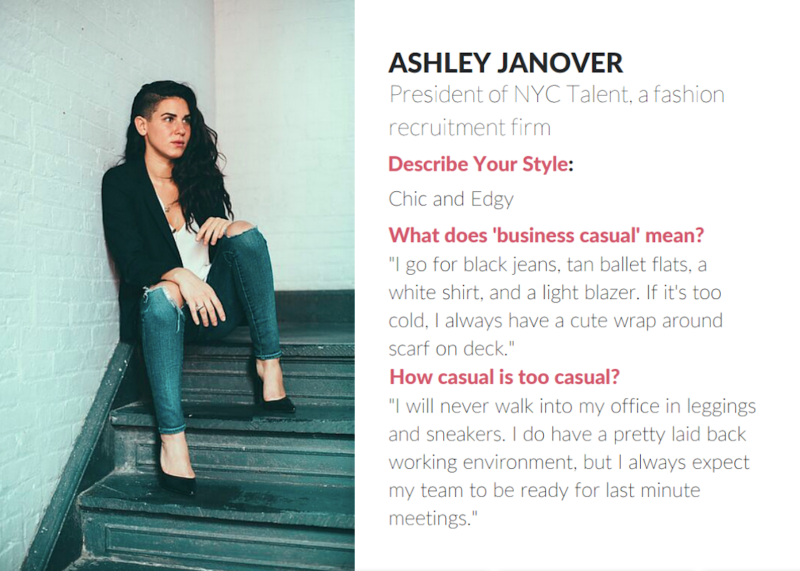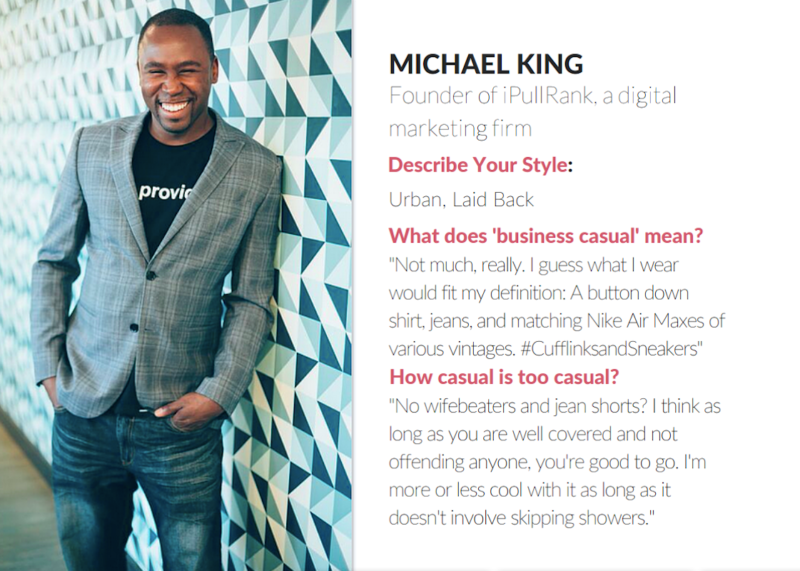We’ve all been there: an email pops up in our inbox inviting us to some sort of work event. At the bottom of the event invite, a sneaky four-word directive perplexes us: “Dress code: Business casual.”
I can’t tell you how many times I’ve argued with parents and friends over what this actually means, but when I walked into orientation on my first day at WeWork, I knew I wasn’t alone in my confusion. There were about 20 new hires at the meeting that day, and each of them had interpreted “business casual” a bit differently. There were blazers, T-shirts, ties, jeans, dresses, and even a chic jumpsuit.
The fact that nobody knows what business casual means anymore is highlighted by Wikipedia’s definition of the term: “an ambiguously-defined dress code that has been adopted by many professional and white-collar workplaces in Western countries. It entails neat yet informal attire and is generally more casual than informal business attire.”

Nowadays, “business casual” is much more individualized than it used to be, with factors like industry, city, and company age informing acceptable dress code. But where did this phrase even come from?
Casual Fridays had already become de rigueur at top companies in the ‘50s and ‘60s. But with the rise of Silicon Valley, HR departments despaired as the “too casual” look began to seep into the rest of the week. Companies clamored for a unified dress code that was not as buttoned-up as previous decades, but still retained an air of professionalism. In the early ‘90s, Levi’s, an unlikely hero, saw a market gap and stepped in to define a smart, but casual dress code.

Enter an unassuming eight-page pamphlet called “A Guide to Casual Businesswear,” sent to 25,000 HR managers in 1992 by Levi Strauss & Co. Featuring button downs, smart loafers, and importantly, tailored khakis, the pamphlet was a subtle guerilla marketing move for the company’s newly acquired brand, Dockers. Part of the pamphlet’s genius was that none of the looks were overtly branded, but many featured workers wearing the tailored beige pants. Included in the booklet was a hotline for office dress code concerns.
Over 20 years ago, Levi’s simple but brilliant marketing campaign set the golden standard of business casual across America. However, business dress codes, especially in the tech community, have come a long way since the ‘90s.

We seem to be in a transitional phase, somewhere between Levi’s Business Casual and what I like to call Creative Business Casual. This is due in part to an increased emphasis on expressing oneself in the office, as well as the ubiquity of wearable company swag—branded T-shirts and apparel. Nowadays, there really is no definition for business casual. It’s whatever you feel productive in, and what you want your outward reflection in the world to be. It’s still important to look and feel professional for the workplace, and to project that professionalism to clients. However, whatever version of “professional” you are is entirely up to you.
The only real style advice we can give is in the form of our trendsetting colleagues, who always seem to be put together. Young professionals and CEOs now rep the new business casual and give opinions on dress code dilemmas.

In the end, you can always emulate a stylish office friend, but never forget to give it your own twist. Dressing for work nowadays is all about injecting your look with a bit of personality.







